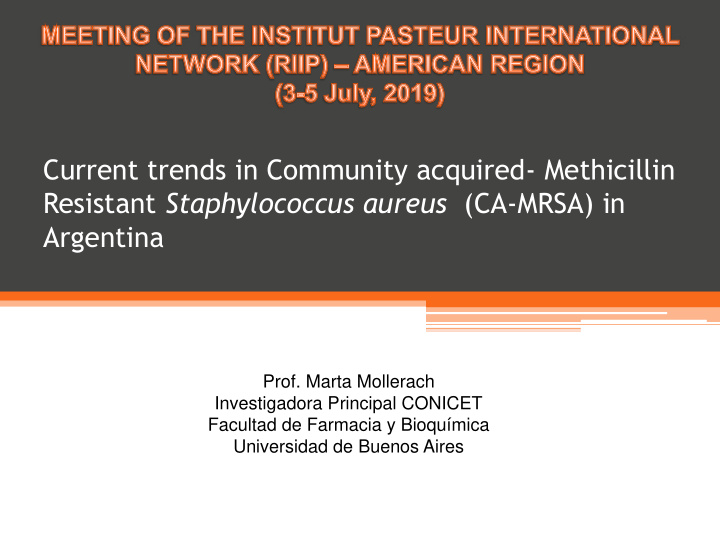



Current trends in Community acquired- Methicillin Resistant Staphylococcus aureus (CA-MRSA) in Argentina Prof. Marta Mollerach Investigadora Principal CONICET Facultad de Farmacia y Bioquímica Universidad de Buenos Aires
STRATEGIC OBJECTIVES Awareness and education Surveillance of antimicrobial resistance Infection prevention and control Optimal use of antimicrobial medicines in human and animal health R&D and investment 2015
Meticillin resistant Global priority list of pathogens to guide Staphylococcus aureus research, discovery, and development of new antibiotics (MRSA) HIGH PRIORITY
Staphylococcus aureus, MRSA and CA-MRSA 25% to 30% of people are colonized most common cause of skin and soft tissue infections By the end of 20 th century, another type endocarditis, osteomyelitis, of MRSA emerged among healthy pneumonia, toxic shock syndrome people in the community (CA-MRSA) Methicillin Resistant S. aureus (MRSA) Since 1960 ….MRSA = Nosocomial infection Worldwide pandemia of MRSA in hospitals
Comparison of typical CA-MRSA and HA-MRSA • SCC mec IV, V CA-MRSA • More susceptible to other families of antibiotics • Particularly virulent. • SCC mec I, II o III HA-MRSA • Multiresistant
Evolution of MRSA in Argentina (HA-MRSA clones) 13 Hospitals 62,2% Brazilian clone ST239-MRSA-III 1998 (CABA, Pcia Bs As, Tucumán) Corso et al., 1998 Emergence of “ Cordobés” clone ST5-MRSA-I 2002 6 Hospitals Similar prevalence than ST239-MRSA-III Córdoba Sola et al., 2002 Prevalence of Cordobés clone ST5-MRSA-I 2 Hospitals 2005 Buenos Aires Gardella, Mollerach M., 2005 Presence of Cordobés clone ( ST5-MRSA-I ) 2009 and > community clones in hospitals ( ST5- 66 Hospitals MRSA-IV, ST30-MRSA-IV ) Egea et al., 2014 Presence of community ( ST5-MRSA-IV, ST30- 2012-2016 1 Hospital MRSA-IV ) > hospital ( ST5-MRSA-I ) clones in (CABA) hospitals Di Gregorio S, Mollerach M, 2015
Global distribution of CA-MRSA clones DeLeo et al, 2010
Molecular epidemiology of CA-MRSA in Argentina. First reports Eur J Clin Microbiol, 2006 PFGE A - ST5 - SCC mec IV PFGE C – ST30 - SCCmecIV
Guidelines for the treatment of skin and soft tissue infections. Argentina - 2009 Forunculosis, carbunclo and piomiositis, celulitis & impétigo Empiric treatment based on β -lactam antibiotics but …. Patients with sistemic manifestations Vancomycin, linezolid, Daptomycin
… questions in the CA-MRSA era Prevalence of SSTIs caused by CA-MRSA in Argentina? Must we change guidelines for empirical treatment of these infections? Is ST5 – SCCmec IV clone still dominant in Argentina? UBA & SADI (Argentinean Society for Infectious Diseases) Two prospective multicenter studies 1) Skin and soft tissue infections caused by MRSA 2) MRSA Invasive infection
Skin and Skin Structure Infections 311 patients were enrolled 271 (87%) positive cultures 19 Institutions • 265 (85%) Monomicrobial 11 Bs.As. city • 7 Bs.As. Province • 1 Santa Fe 248 (80%) S. aureus Province 218 (70%) MRSA CA-MRSA has become the most frequent cause of SSSIs (70%) in our population
Invasive infections Skin and skin structure infections (SSSIs)
ST 30-IV predominant clone causing SSSIs (65 % ) and invasive infections (82%) * 100 90 80 ST30-IVc-t019/rel 70 % Isolates 60 50 ST5-IVa-t311 64,4 % 82% 40 30 20 24 % 10 7% p=0,029, Fisher’s exact test 0 IPER INVASIVAS SSSIs Invasive Infections The association between ST30 and invasive infection is significant Is the new predominant clone more virulent?
(ST30 vs. ST5) Different virulence genes profile Acute oteomyelitis Skin infection model model ** * Higher virulence in 1000000 1 10 0 9 Bacterial load (CFU/lesion) two animal models 1 10 0 8 1 10 0 7 100000 UFC/tibia of infection 1 10 0 6 1 10 0 5 10000 1 10 0 4 1 10 0 3 1000 ST5 ST 30 ST 5 ST 30 ST30 – SCCmecIV is a High Risk Clone (HRC)
New questions to be answered concerning ST30- IV… Work in progress using WGS I s there any genomic change in ST30-MRSA-IV from 2005 to 2010-2011 that cause the expansion of this clone? Did it acquire additional resistance/virulence determinants? Genomic surveillance of MRSA Microevolution of MRSA in the lungs of CF patients
David Aanensen / Silvia Argimón Centre for Genomic Pathogen Surveillance, United Kingdom Agnes Marie S. Figueiredo , Federal University of Rio de Janeiro, Brasil Nilton Lincopan. Institute of Biomedical Sciences, Universidade de São Paulo, Brazil. Alessandro Silveira . Universidad Regional de Blumenau, Santa Catarina, Brasil. Teresa Camou , Departamento de Laboratorios, Ministerio de Salud Pública, Uruguay Gustavo Varela , Facultad de Medicina, Universidad de la República, Uruguay Rosa Guillen Fretes , Departamento de Biología Molecular y Biotecnología, Universidad Nacional de Asunción, Paraguay Mario Fabián Martínez Mora , Laboratorio Central de Salud Pública, Paraguay Norah Balderrama Yarhui , , Hospital del Niño “Manuel Ascencio Villarroel”, Bolivia Lorena M. Soleto Ortiz, Centro Nacional de Enfermedades Tropicales, Bolivia Josefina Campos, Plataforma genómica y bioinformática, INEI-ANLIS Dr Carlos G. Malbrán, Argentina LEAD OVERSEAS RESEARCHER UK CO-APPLICANT Prof. Dr. Marta Mollerach Prof. Dr. David Aanensen Facultad de Farmacia y Bioquímica-UBA The Centre for Genomic Pathogen CONICET – Independent Researcher Surveillance - Wellcome Sanger Institute
Our specific aims are: 1. To establish a genomic surveillance network of S. aureus that allows : A- study the population structure of S. aureus strains in SA, B- identify the circulating clones in the region and compare them within a global context, C- determine the presence of virulence factors and antibiotic resistance genes. 2. To develop regional capabilities for the sequencing and bioinformatic analysis of whole genomes of S. aureus.
Facultad de Farmacia y Bioquímica Universidad de Buenos Aires (UBA) Thank you for Dra Sabrina Di Gregorio Sol Haim (PhD student) your attention!! Lucia Gulone (PhD student) Dra Arabela Cuirolo Dra Noella Gardella Dra Martha von Specht Dra Silvina Fernandez Dra Melina Herrera Dra Angela Famiglietti ( Hospital de Clinicas. UBA) MRSA Working Group - Argentinean Society for Infectology Children`s Hospital R- Gutierrez (Cystic Fibrosis Group) Facultad de Medicina Universidad de Buenos Aires. S. aureus Group IMPaM- Conicet Dr. Daniel Sordelli / Dra. Marisa Gómez
Recommend
More recommend